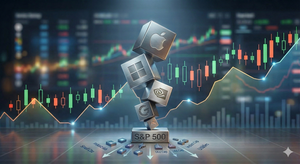
The financial world is currently grappling with a pivotal question: Is the United States headed for an economic recession, or is a broader global contraction on the horizon? Expert opinions are deeply divided, with some forecasting a relatively benign year for the U.S. while others warn of significant downturns both domestically and worldwide. The interplay of persistent inflation, aggressive trade policies, and a delicate labor market balance creates a complex economic tapestry, leaving investors and policymakers scanning for clearer signals amidst the noise.
The Shifting Sands of Recession Probabilities
The debate surrounding recession probabilities for 2025 is intense and varied. On one hand, institutions like Goldman Sachs Research (NYSE: GS) and economists surveyed by Wolters Kluwer and SIFMA have expressed optimism, citing upwards revisions in growth estimates and a strong, rebalancing labor market. Goldman Sachs, for instance, projects 2.5% GDP growth for 2025, downplaying recession fears. Similarly, Vanguard's global chief economist does not see a recession as their baseline expectation. This perspective often points to a resilient U.S. economy on "solid ground," capable of navigating current headwinds.
However, a significant portion of experts holds a more cautious, if not outright pessimistic, view. J.P. Morgan Research (NYSE: JPM), despite lowering its joint U.S. and global recession probability to 40% (from 60%), still highlights "considerable downside risk" and anticipates sub-par growth. More strikingly, UBS reported in September 2025 that "hard data" indicated a 93% probability of an economic downturn, though they stopped short of forecasting a full recession, instead predicting an "extended phase of stagnant economic growth." Apollo Chief Economist Torsten Slok went further, positing a 90% probability of a U.S. recession in 2025 if current tariff policies persist. The International Monetary Fund (IMF), while generally revising global growth upwards to 3.0% for 2025, still acknowledges "downside risks from potentially higher tariffs, elevated uncertainty, and geopolitical tensions." These diverging forecasts underscore the profound uncertainty stemming from key indicators such as new tariffs and trade policies (especially the U.S.-China trade war), the Federal Reserve's interest rate trajectory, the health of the labor market, consumer spending, industrial production, and the perennially watched inverted yield curve.
Recession's Uneven Hand: Identifying Winners and Losers
In any economic downturn, certain sectors and companies are better positioned to weather the storm, while others face significant headwinds. The current environment, marked by inflation and evolving trade policies, amplifies these distinctions.
Companies and Sectors Poised to Win: Consumer Staples companies, which provide essential goods, are typically resilient. Discount retailers like Walmart (NYSE: WMT), Dollar General (NYSE: DG), and Dollar Tree (NASDAQ: DLTR) often see increased traffic as consumers become more price-sensitive. Producers of packaged goods such as Procter & Gamble (NYSE: PG), Unilever (NYSE: UL), and The Clorox Co. (NYSE: CLX) maintain stable demand for their everyday necessities. Healthcare companies, including those in pharmaceuticals and medical devices, also tend to hold up well, as medical needs are largely non-discretionary. Utilities, providing electricity, water, and gas, offer stable demand and reliable dividends. Lastly, businesses offering repair and maintenance services or B2B software solutions focused on efficiency and cost-cutting (e.g., cloud services from Microsoft (NASDAQ: MSFT) or Amazon Web Services (NASDAQ: AMZN)) can thrive as both consumers and businesses seek to optimize existing assets and streamline operations.
Companies and Sectors Likely to Lose: Conversely, Consumer Discretionary businesses, which rely on non-essential spending, are highly vulnerable. Luxury retailers, high-end apparel companies, and producers of new automobiles are often among the first to see demand decline. The Hospitality and Travel sector, encompassing airlines (e.g., Delta Air Lines (NYSE: DAL), United Airlines Holdings (NASDAQ: UAL)), hotels, and restaurants, faces sharp declines as both leisure and business travel are curtailed. Real Estate and Construction are hit by tighter credit conditions and reduced investment. Manufacturing, particularly automotive and electronics, suffers from declining consumer demand and supply chain disruptions, reminiscent of challenges faced by General Motors (NYSE: GM) and Chrysler during the 2008 recession. The Financials sector is exposed to increased loan defaults, while the highly cyclical Energy sector sees demand and prices plummet. Consumer tech companies like Tesla (NASDAQ: TSLA), if relying on high discretionary spending, could also face significant headwinds, as recent reports have indicated challenges for such corporations in 2025.
The distinction between a U.S. and a global recession further refines these outlooks. A U.S. recession primarily impacts domestic sectors. However, a global recession intensifies challenges for companies with significant international operations and complex global supply chains. Current trade policies, such as tariffs, introduce uncertainty, increasing costs for businesses and dampening investment globally, which disproportionately affects multinational corporations.
Broader Implications and Historical Echoes
A potential U.S. or global recession would embed itself within broader economic trends, creating ripple effects across industries and demanding specific policy responses. Recessions are cyclical, often following periods of excessive debt, speculation, or sudden supply shocks (like rising energy costs) or aggressive contractionary monetary policies.
The broader industry impact would see a general contraction, with consumer discretionary, manufacturing, construction, and financial sectors typically suffering the most. Beyond immediate financial losses, recessions leave "economic scarring" through higher unemployment, lower wages, and reduced investment in R&D, potentially hindering long-term growth and innovation. Poverty and inequality can worsen, and government finances strain under declining tax revenues and increased social safety net spending. However, downturns can also spur market consolidation, driving efficiency and innovation as weaker businesses exit, allowing stronger ones to expand.
In response, governments and central banks typically deploy expansionary monetary policies (like interest rate cuts) and fiscal stimulus (such as infrastructure spending and tax cuts) to boost demand. The U.S. Federal Reserve, for instance, has historically used its emergency authority to inject liquidity into financial markets during crises. Regulatory reforms often follow severe downturns, as seen with the Dodd-Frank Act after the Great Recession (2007-2009), aiming to prevent future systemic risks.
Historically, the U.S. has experienced numerous recessions, from the severity of the Great Depression (1930s) to the swift, sharp COVID-19 recession (2020). These events often coincide with global downturns, underscoring the interconnectedness of the world economy. The common thread in these historical precedents is the interplay of economic imbalances, external shocks, and subsequent policy interventions aimed at stabilization and recovery.
What Comes Next: Navigating the Economic Currents
Looking ahead, the economic landscape presents a dichotomy of short-term volatility and long-term adaptation. In the near term, businesses should brace for declining sales, tighter credit, and potential cash flow issues. Cost control, workforce optimization, and efficient management of receivables will be paramount. Companies with agility and adaptability, capable of quickly pivoting to changing consumer needs or market conditions, will be better positioned to survive and potentially gain market share. This includes leveraging technology for efficiency and exploring diversified revenue streams.
Long-term possibilities include prolonged periods of slow growth, especially if "economic scarring" impacts education, investment, and innovation. Increased public debt, due to stimulus measures, could also lead to future fiscal challenges. However, recessions also foster innovation and restructuring, allowing stronger companies to emerge more efficient and dominant.
For investors, opportunities may arise in value investing during market dips and in defensive sectors like healthcare and consumer staples. Companies with strong balance sheets and cash reserves may also be attractive. Mergers and acquisitions can increase as valuations decline, allowing well-capitalized firms to expand strategically. On the other hand, significant challenges include continued market volatility, increased competition, persistent inflation, and potentially lower overall investment. Strategic communication, employee skill-building, and a focus on customer retention will be crucial for businesses. While J.P. Morgan adjusted its recession probability, the expectation of weak growth due to tariff shocks highlights the ongoing uncertainty.
Conclusion: A Delicate Balance and Watchful Waiting
The current economic outlook is a delicate balance, poised between divergent forecasts for U.S. and global recession probabilities. While some indicators suggest a resilient U.S. economy, others flash warning signs of a broader downturn, exacerbated by inflation and protectionist trade policies. The potential for economic scarring, increased inequality, and strained government finances underscores the severity of a sustained contraction, whether domestic or global.
Moving forward, investors should remain vigilant, closely monitoring key economic indicators such as inflation trends, central bank actions, consumer confidence, and global trade developments. Businesses, in turn, must prioritize agility, cost efficiency, and strategic adaptation to navigate the turbulent waters. The coming months will be critical in determining whether the U.S. achieves a soft landing, or if the world faces a more profound and synchronized economic contraction, with lasting implications for markets and livelihoods. The ability to innovate, conserve resources, and respond strategically will be the defining characteristic of economic resilience in this uncertain era.





